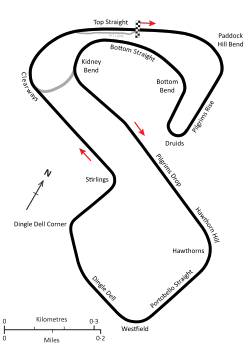| 1971 World Championship Victory Race | |||
|---|---|---|---|
| Non-championship race in the 1971 Formula One season | |||
 | |||
| Race details [1] | |||
| Date | 24 October 1971 | ||
| Official name | Rothmans World Championship Victory Race | ||
| Location | Brands Hatch, Kent | ||
| Course | Permanent racing facility | ||
| Course length | 4.265 km (2.65 miles) | ||
| Distance | 40 laps, 170.59 km (106 miles) | ||
| Pole position | |||
| Driver | BRM | ||
| Time | 1:22.8 | ||
| Fastest lap | |||
| Driver | | Lotus | |
| Time | 1:24.0 | ||
| Podium | |||
| First | BRM | ||
| Second | Lotus | ||
| Third | Tyrrell | ||

The Rothmans World Championship Victory Race [2] was a motor race, run to Formula One rules, held on 24 October 1971 at Brands Hatch, Kent. The race was to be run over 40 laps of the circuit, but was stopped and abandoned on lap 15 following the fatal accident suffered by Swiss driver Jo Siffert. The result was taken from the race order after 14 laps, with Peter Gethin being declared the winner in his BRM P160. The entry included several Formula 5000 cars which were contesting Round 12 of the 1971 Rothmans European Formula 5000 Championship.
Contents
Siffert's accident led to a rapid overhaul of safety, both in-car and on circuit. In the subsequent Royal Automobile Club (the UK organising and regulatory representative of the FIA at the time) investigation, it was discovered that the crash itself caused non-fatal injuries but Siffert had rather been killed by smoke inhalation. None of the trackside fire extinguishers worked, and it was found to be impossible to reach the car and extract Siffert because of the intense fire. On-board fire extinguishers (using BCF—Bromochlorodifluoromethane, an aircraft product) became mandatory and also piped air directly into the drivers' helmets.[ citation needed ]